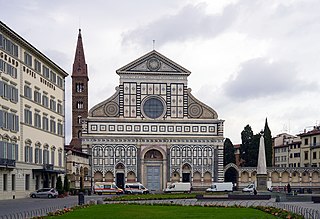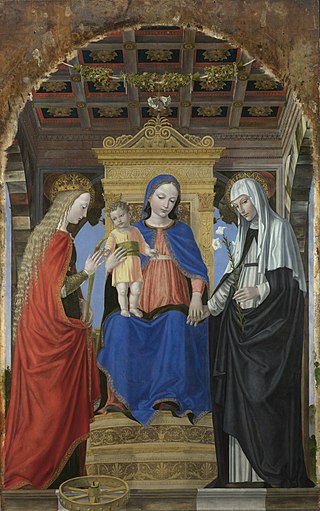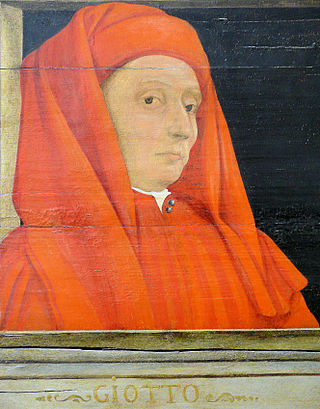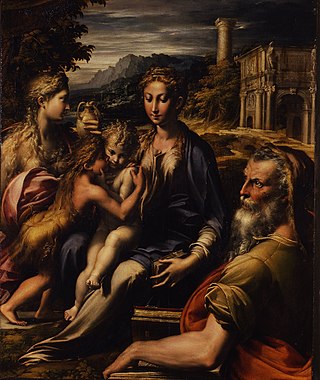
Antonio Allegri da Correggio, usually known as just Correggio was an Italian Renaissance painter who was the foremost painter of the Parma school of the High Renaissance, who was responsible for some of the most vigorous and sensuous works of the sixteenth century. In his use of dynamic composition, illusionistic perspective and dramatic foreshortening, Correggio prefigured the Baroque art of the seventeenth century and the Rococo art of the eighteenth century. He is considered a master of chiaroscuro.

Santa Maria Novella is a church in Florence, Italy, situated opposite, and lending its name to, the city's main railway station. Chronologically, it is the first great basilica in Florence, and is the city's principal Dominican church.

Lorenzo Lotto was an Italian Renaissance painter, draughtsman, and illustrator, traditionally placed in the Venetian school, though much of his career was spent in other north Italian cities. He painted mainly altarpieces, religious subjects and portraits. He was active during the High Renaissance and the first half of the Mannerist period, but his work maintained a generally similar High Renaissance style throughout his career, although his nervous and eccentric posings and distortions represented a transitional stage to the Florentine and Roman Mannerists.

The Basilica di Santa Croce is a minor basilica and the principal Franciscan church of Florence, Italy. It is situated on the Piazza di Santa Croce, about 800 metres southeast of the Duomo, on what was once marshland beyond the city walls. Being the burial place of notable Italians, including those from the Italian Renaissance such as Michelangelo, Galileo, and Machiavelli, as well as the poet Foscolo, political philosopher Gentile and the composer Rossini, it is also known as the Temple of the Italian Glories.

Girolamo Francesco Maria Mazzola, also known as Francesco Mazzola or, more commonly, as Parmigianino, was an Italian Mannerist painter and printmaker active in Florence, Rome, Bologna, and his native city of Parma. His work is characterized by a "refined sensuality" and often elongation of forms and includes Vision of Saint Jerome (1527) and the iconic if somewhat anomalous Madonna with the Long Neck (1534), and he remains the best known artist of the first generation whose whole careers fall into the Mannerist period.

Museo di Capodimonte is an art museum located in the Palace of Capodimonte, a grand Bourbon palazzo in Naples, Italy designed by Giovanni Antonio Medrano. The museum is the prime repository of Neapolitan painting and decorative art, with several important works from other Italian schools of painting, and some important ancient Roman sculptures. It is one of the largest museums in Italy. The museum was inaugurated in 1957.

Bardi is a comune (municipality) in the Province of Parma in the Italian region Emilia-Romagna, located about 130 kilometres (81 mi) west of Bologna and about 50 kilometres (31 mi) southwest of Parma, in the upper Ceno valley at the confluence of the rivers Ceno and Noveglia. It is dominated by the imposing Landi Castle built over a spur of red jasper.

The Shrine of Santa Maria della Steccata is a Greek-cross design Renaissance church in central Parma, Italy. The name derives from the fence in the church. A Nursing Madonna is enshrined within, crowned on 27 May 1601 by a Marian devotee, Fray Giacomo di Forli of the Capuchin order. Pope Benedict XVI raised the Marian sanctuary to the status of Basilica minor on 9 February 2008.

The mystical marriage of Saint Catherine covers two different subjects often shown in Catholic art arising from visions received by either Catherine of Alexandria or Catherine of Siena (1347–1380), in which these virgin saints went through a mystical marriage wedding ceremony with Christ, in the presence of the Virgin Mary, consecrating themselves and their virginity to him.

Lorenzo di Bicci was an Italian painter of the Florentine School considered to be one of the most important painters in Florence during the second half of the 14th century. He is believed to have learned his trade from his father, about whom little is known. Lorenzo’s style, as well as that of his contemporaries Jacopo di Cione and Niccolò di Pietro Gerini, was influenced by the artist Andrea di Cione. Lorenzo's paintings made use of bright colors and his compositions avoided complexity. The figures he painted tended to have round faces and were often expressionless. Another one of Lorenzo's distinctive characteristics was his precision of execution. He was known for exceptional talent in drawing, an ability that he put to use at the initial stages of his painting. Unlike many celebrated Florentine artists of this period, Lorenzo mostly received commissions from the country clergy and from the lower-middle-class Florentine guilds. His successors, Bicci di Lorenzo and Neri di Bicci, continued to serve these groups.

Giotto di Bondone, known mononymously as Giotto, was an Italian painter and architect from Florence during the Late Middle Ages. He worked during the Gothic and Proto-Renaissance period. Giotto's contemporary, the banker and chronicler Giovanni Villani, wrote that Giotto was "the most sovereign master of painting in his time, who drew all his figures and their postures according to nature" and of his publicly recognized "talent and excellence". Giorgio Vasari described Giotto as making a decisive break from the prevalent Byzantine style and as initiating "the great art of painting as we know it today, introducing the technique of drawing accurately from life, which had been neglected for more than two hundred years".

Self-Portrait in a Convex Mirror is a painting by the Italian late Renaissance artist Parmigianino. It is housed in the Kunsthistorisches Museum, Vienna, Austria.

San Giovanni Evangelista is a Mannerist-style, Roman Catholic church located on Piazzale San Giovanni, located just behind the apse of the Parma Cathedral, in the historic center of Parma, northern Italy. The buildings surrounding the piazza were also part of a former Benedictine convent. The church is notable for its Correggio frescoes.

The Circumcision, a painting by the Italian Mannerist artist Parmigianino of the common subject of the circumcision of Jesus, was executed around 1523 and is now in the Detroit Institute of Arts, Michigan, United States.

The Vision of Saint Jerome of The Madonna and Child with Saints is a painting by the Italian Mannerist artist Parmigianino, executed in 1526–1527. It is in the collection of the National Gallery, in London.
(The) Mystic(al) Marriage of Saint/St. Catherine may refer to any of a large number of paintings of the Mystical marriage of Saint Catherine, a few of which are:

The Mystic Marriage of St Catherine is a c.1529 oil on panel painting of the mystical marriage of Saint Catherine by Parmigianino, now in the National Gallery, London, who acquired it in 1974. It was engraved by Giulio Bonasone.

Mystic Marriage of Saint Catherine or Mystic Betrothal of Saint Catherine is a c.1524 oil on canvas painting by the Italian Renaissance painter Parmigianino. The work is now in the Galleria nazionale di Parma. Art historians argue that the work may be attributed to the period in which Parmigianino was painting his first works in the church of San Giovanni Evangelista, as also emerges from a recent restoration, which has shown that its technique is near-identical to that of Parmigianino - "no underdrawing, pigment use, descriptive speed, drafting of final shadows, using fingers and brush-ends as tools".

Portrait of a Man in a Red Beret or Self-Portrait in a Red Beret is an oil on paper painting attributed to Parmigianino or Michelangelo Anselmi, executed c. 1540. It is held in the collection of the National Gallery of Parma.

Madonna and Child with Saint Zechariah is an oil on panel painting by Parmigianino, from c. 1530-1533. It is held in the Uffizi, in Florence. It shows the Madonna and Child with Zechariah, father of John the Baptist.


















